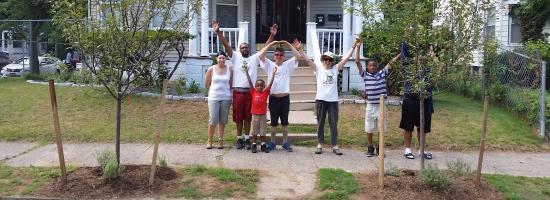
Stewardships Tips and Technical Advice
Tree Care Tips
Why Water When it Rains?
Newly planted trees don’t have enough roots to support their leaves. When a tree grows in a forest from seed, its leaves and roots develop in response to each other. As the roots spread outwards, accessing water and nutrients in the soil, the tree is able produce more above-ground tissue (stems and leaves). With more leaves receiving energy from the sun and producing more carbohydrates for the tree through photosynthesis, the tree is able to grow more roots. The roots and leaves grow in partnership with each other to nurture the long-term health, vigor, and vitality of the tree. Your new tree will be able to support itself eventually. However, for the first three years, it will function much differently and depend on you for its survival.
Why? Before your tree arrived, it was growing happily in a tree nursery. In order to transport the tree to your house, a machine called a tree spade amputated a significant amount of roots and lifted the tree out of the ground. The tree was then wrapped in burlap and secured by a wire basket. This 300-pound package was delivered to your house and planted by one of our trusty GreenSkills planting crews. In order to maintain the tree’s canopy, which is very important, the relatively small amount of roots left are responsible for providing water and nutrients to the tree. With your diligent watering every week, the roots will be able to feed the tree and most importantly grow.
Sleep, creep, leap: During the first year, most of the tree’s growth will be underground in the root system. In the second year, the roots will continue to grow and access more areas of the soil and you will begin to see signs of growth in the canopy. And finally, in the third year, after the root network has recovered, your tree will grow in leaps and bounds- a satisfying sight to see after your committed stewardship!
How much water?
25 gallons once a week! A deep soaking is needed for enough water to penetrate the root ball. A deep soaking also will allow the water to reach deeper levels of the soil so that new roots will establish well below the surface enabling the tree to have a higher capacity to withstand future droughts.
Water your tree EVEN WHEN IT RAINS! Most storms do not produce enough rain (at least one inch) to keep up with the amount of water the tree needs.
WHAT’S MULCH GOT TO DO WITH IT?
Mulch mimics nature. It resembles the woody debris found on the forest floor and provides the following services:
1) It keeps the roots cooler with the few inches of insulation it provides.
2) It reduces the amount of weeding needed to cut down on plants that would compete with the tree for nutrients and water.
3) Most importantly, it helps retain moisture after watering.
Mulch biodegrades, so if your tree needs more mulch, replace it. How? Place the mulch in a doughnut shape around the tree 2-3 inches high, so the water in the doughnut hole would drain toward the stem. The mulch doughnut should be about 2 inches away from the base of the tree and should never bury the tree’s root flare. (Watch this root flare movie to learn more about root flares.)
After mulching, be sure to water that tree. It’s thirsty!
